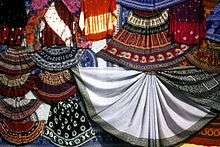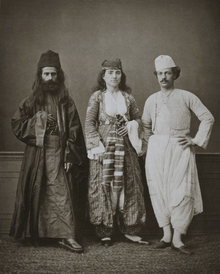Ethnic groups in Asia
In terms of Asian people, there is an abundance of ethnic groups in Asia, with adaptations to the climate zones of the continent, which include Arctic, subarctic, temperate, subtropical or tropical, as well as extensive desert regions in Central and Western Asia. The ethnic groups have adapted to mountains, deserts, grasslands, and forests, while on the coasts of Asia, resident ethnic groups have adopted various methods of harvest and transport. The types of diversity in Asia are cultural, religious, economic and historical.

Some groups are primarily hunter-gatherers, whereas others practice transhumance (nomadic lifestyle), have been agrarian for millennia, or have adopted an industrial or urban lifestyle. Some groups or countries in Asia are completely urban (e.g., Hong Kong and Singapore); the largest countries in Asia with regard to population are the People's Republic of China, India, Indonesia, Pakistan, Bangladesh, Japan, Philippines, Vietnam, Iran, Thailand, Burma, and South Korea. Colonisation of Asian ethnic groups and states by European peoples beginning in the 16th century, reaching its peak in the late 19th and early 20th centuries (except in the former Soviet Union, which was dissolved in 1990).
Central Asia
Central Asia, in its most common definition, is deemed to consist of five former Soviet Socialist Republics: Kazakhstan, Kyrgyzstan, Tajikistan, Uzbekistan, Turkmenistan and Xinjiang of western China. In a wider view, Mongolia, Afghanistan, and northern Pakistan are included. Turkic, Indo-Iranian, and Mongolic peoples comprise its general ethnicities.
The main religions of Central Asia are Islam (Turkic/Indo-Iranian peoples) and Buddhism (Mongolia). Central Asia has a long, rich history mainly based on its geographical location along the ancient Silk Road. It has been conquered by Mongols, Tibetans, Persians, Tatars, Russians, Afghans and Sarmatians, and thus has a very distinct, vibrant culture. The culture is influenced by Chinese, Indian, Persian, Afghan, Arabian, Turkish, Russian, Sarmatian and Mongolian cultures.
The music of Central Asia is rich and varied and is appreciated worldwide. Meanwhile, Central Asian cuisine is one of the most prominent cuisines of Asia, with cuisines from Pakistan, India, China and Azerbaijan showing significant influence from the foods of Central Asia. One of the most famous Central Asian foods is the kebab.
The literature of Central Asia is linked with Persian literature as historically it has been part of the Persian Empire for a lot of its history. Furthermore, sitting at the junction of the Silk Road, it has numerous Chinese, Indian and Arabian literary works.
East Asia

East Asia, in general terms, consists of China, Hong Kong, Macao, Taiwan, Japan, South Korea North Korea and Mongolia; sometimes, Vietnam is included in the definition. The major ethnicities of East Asia are: Han, Yamato, and Korean. Other ethnic groups of East Asia include: Tibetan, Uyghur, Kazakh, Kyrgyz, Manchu, and Mongol. Geographically East Asians farther north would also include groups such as the Buryats, Evenks, Yakuts, but due to the national and political dividing lines, the inclusion of East Asians north of China and Mongolia is not considered.
Mainly, the language families or isolates of East Asia are: Sinitic, Tibeto-Burman, Japonic, Ainu languages, the Korean language, Mongolic, Tungusic, Turkic, Miao–Yao, Tai–Kadai and Mon–Khmer;
The dominant influence historically has been China, whose area of cultural influence is generally known as the Sinosphere. Evidence of this can be seen in the cuisine, architecture, and lexicons, for example, throughout the region; in modern times, however, cultural exchange has flowed more bi-directionally. Major characteristics of this region include shared Chinese-derived language characteristics, as well as similar social and moral philosophies derived from Confucianism.
The script of the Han Chinese has long been a unifying feature in East Asia as the vehicle for Chinese culture. It was passed on first to Korea, Vietnam in the 1st century, then to Japan, where it forms a major component of the Japanese writing system. In Korea, however, Sejong the Great invented the hangul alphabet based on the Chinese characters, which has since been used as the main orthographic system for the Korean language. A similar phenomenon occurred in Vietnam, where the Chinese-based Chữ nôm script once used to write the Vietnamese language has been gradually superseded by the Latin-based Vietnamese alphabet during the period of the French colonisation. In Japan, much of the Japanese language is written in hiragana, katakana in addition to Chinese characters.
Apart from the unifying influence of Confucianism, Buddhism, Taoism, Chinese characters, Chinese architecture, and other Chinese cultural influences, there is nevertheless diversity between the countries of the region.
North Asia
For the most part, North Asia is considered to be made up of the Asian part of Russia solely. North Asia is geographically the northern extremenity of East Asia and the physical characteristics of its native inhabitants generally resemble that of East Asians, however this is principally divided along political lines under separate national identities, particularly that of China, Mongolia and Russia. The main ethnic groups of the region speak languages of the Uralic, Turkic, Mongolic, and Tungusic language families, along with East Slavs and various "Paleo-Siberian" peoples, with most of these ethnic groups being composed of nomads or people with a nomadic history.
The geographic region of Siberia was the historical land of the Turkic people, the Tatars, in the Siberia Khanate. Russia, under expansion of its territory however, took control of the region now known as Siberia, and thus today it is under Russian rule. There are roughly 40 million people in North Asia.
Southeast Asia
Southeast Asia is often split into two parts: Mainland Southeast Asia, comprising Burma, Cambodia, Laos, Peninsular Malaysia, Thailand, and Vietnam; and Maritime Southeast Asia, which includes Brunei, East Timor, Indonesia, East Malaysia, the Philippines, and Singapore. The region has been greatly influenced by the cultures and religions of India and China, as well as the religions of Islam and Christianity from Southwest Asia.
Southeast Asia seems to be more influenced by India rather than China with the exception of Vietnam, which is considered part of the Sinosphere. Southeast Asia has also had a lot of Western influence due to the lasting legacy of colonialism. One example is the Philippines, which has been heavily influenced by Spain and the United States of America over the course of almost four centuries of colonisation.
A common feature found around the region are stilt houses, while another is rice paddy agriculture, which originated in the region thousands of years ago. Dance is also a very important feature of the culture, utilizing movements of the hands and feet perfected over thousands of years. Furthermore, the arts and literature of Southeast Asia is very distinctive as some have been influenced by Indian, Hindu, Chinese, Buddhist and Islamic literature.
South Asia


South Asia, in general definition, consists of the countries of Bangladesh, Bhutan, India, Maldives, Nepal, Pakistan, Afghanistan and Sri Lanka. The five Southern Indian states share a Dravidian culture, due to the prominence of Dravidian languages there. Sri Lanka has two main languages, Sinhalese which has Indo-Aryan roots and Tamil which has Dravidian roots. Bangladesh and the Indian province West Bengal share common Bengali heritage and culture, with Bangladesh having a prevalent Tibeto-Burman influence on its south-eastern states. Pakistan is split with its two western regions of Baluchistan and Khyber Pakhtunkhwa sharing a greater Iranian heritage and its two eastern provinces of Sindh and Punjab sharing a more Indo-Aryan culture.
Nepal, the states of Sikkim, Arunachal Pradesh, Ladakh in the state of Jammu and Kashmir and parts of the Indian states of Himachal Pradesh, Uttarakhand have a great cultural similarity to Tibet, Tibetan Buddhism being the dominant religion there. Finally the border states of Assam, Meghalaya, Mizoram, Manipur, Nagaland and Tripura have cultural affinities with South East Asia.
Bhutanese are often referred to in literature as "Bhote" (people of Bhutia/Bhotia or Tibet). They follow Tibetan Buddhism to and it is dominant political and cultural element in modern Bhutan. Their language, Dzongkha, is the national language and is descended from Old Tibetan.
Hinduism, Buddhism, Jainism and Sikhism, religions founded in the region that is today's India, are spread throughout the subcontinent. Islam and Christianity also have significant region-specific histories. While India and Nepal have a majority of people following Hinduism, Sri Lanka and Bhutan have a majority of Buddhists. Islam is the second largest religion after Hinduism with Muslim countries like Pakistan and Bangladesh.
Indo-Aryan languages are spoken in Pakistan and most of North, West, East India, Nepal, and southern Sri Lanka. Dravidian languages are spoken in South India and Sri Lanka. Tibeto-Burman languages are spoken in the hills of Bangladesh, Nepal, North and North East India. Austroasiatic languages are spoken in certain northern and eastern areas of Bangladesh and in East and North East India.
West Asia
West Asia largely corresponds with the term the Middle East. West Asia consists of Armenia, Azerbaijan, Bahrain, Cyprus, Iran, Iraq, Israel, Jordan, Kuwait, Lebanon, Oman, Palestine, Qatar, Saudi Arabia, Syria, Turkey, United Arab Emirates and Yemen.
Culturally, the region's dominant ethnic groups are Arab (about 150 million), Turkic (about 60 million) and Persian (about 50 million) and Kurds (about 35 million) alongside smaller but significant numbers of Greek (600 thousand), Jewish people (6.2 million), Assyrian (about 400,000), Armenians, Azeris (about 20 million) and other minorities - such as Mandaeans, Yazidis, Circassians and others. Many of the West Asian countries are desert, and thus many nomadic groups exist today, most notably the Bedouin Arabs.
References
See also
| Wikimedia Commons has media related to Ethnic groups in Asia. |
- Asian people
- Australoid
- Black people
- Brown (racial classification)
- Caucasoid
- Culture of Asia
- Demographics of Asia
- Indigenous peoples of Asia
- Languages of Asia
- Mongoloid
- Negroid
- Proto-Australoid
- White people
